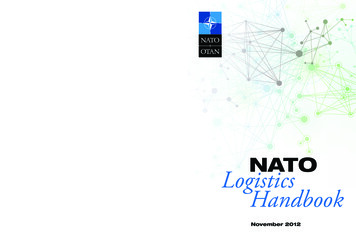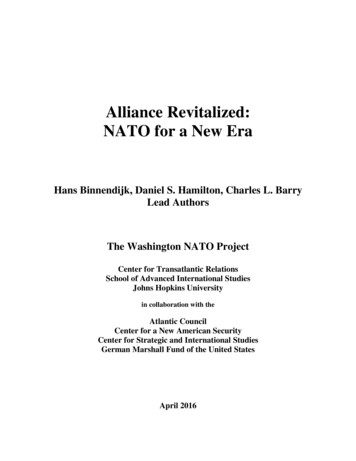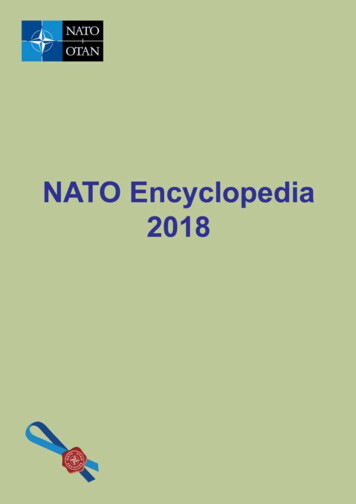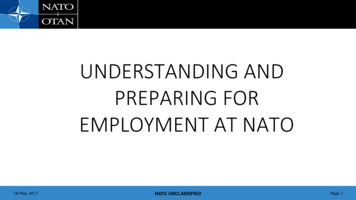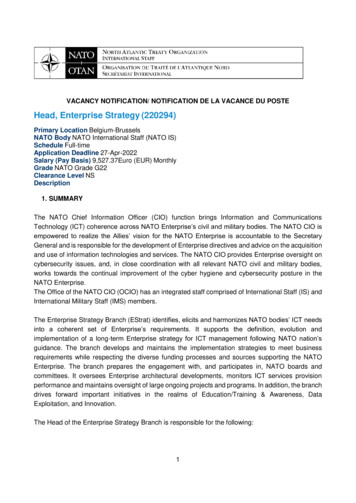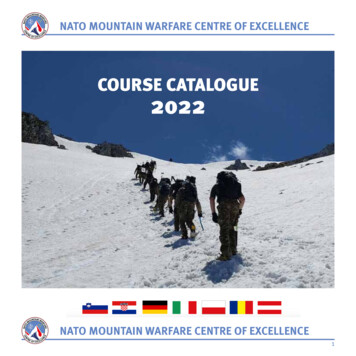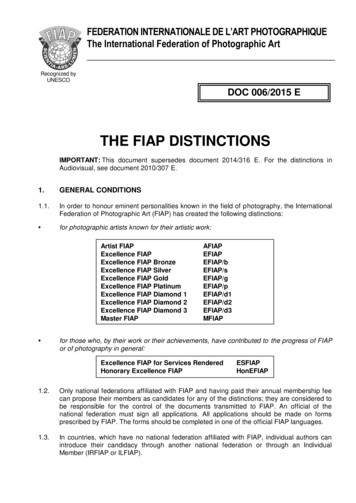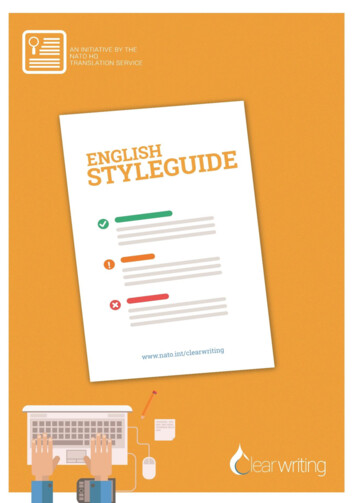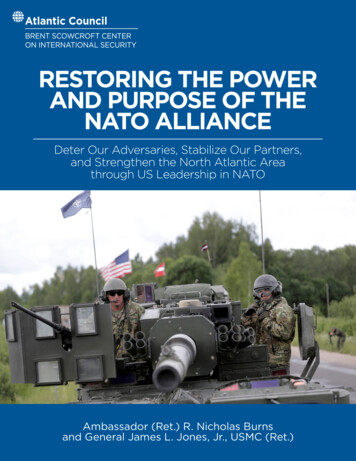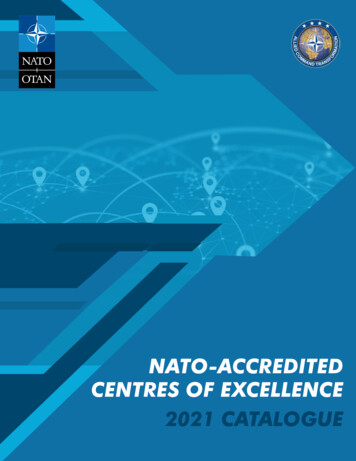
Transcription
NATO-ACCREDITEDCENTRES OF EXCELLENCE2021 CATALOGUE
TABLE OF CONTENTSSACT’s Message.What is a NATO-Accredited COE?.HQ SACT Coordination with COEs.COE Programme Development Branch in 2020.NATO-Accredited Centres of Excellence – Key Documents.COE Frequently Asked Questions.COE Management Framework. COE Steering Committee. COE Director. Chairman of the COE Directors’ Conference.Requesting COE Products and Services. TRANSNET. Centres of Excellence Community of Interest. Requests for Support.Impact of COVID-19.COEs Undergoing the NATO Establishment and Accreditation Process.Map of COE Locations.Current COE Status & Location.Nations Participating in COEs.3456789999101011111213366870NATO-Accredited COEsAir Operations (AO).Civil-Military Cooperation (CCOE).Cold Weather Operations (CWO).Combined Joint Operations from the Sea (CJOS).Command and Control (C2).Confined and Shallow Waters (Operations In) (CSW).Cooperative Cyber Defence (CCD).Counter-Improvised Explosive Devices (C-IED).Counter Intelligence (CI).Crisis Management and Disaster Response (CMDR).Defence Against Terrorism (DAT).Energy Security (ENSEC).Explosive Ordnance Disposal (EOD).Human Intelligence (HUMINT).Joint Air Power Competence Centre (JAPCC).Joint Chemical, Biological, Radiological and Nuclear Defence (JCBRN Defence).Maritime Security (MARSEC).Military Engineering (MILENG).Military Medicine (MILMED).Military Police (MP).Modelling & Simulation (M&S).Mountain Warfare (MW).Naval Mine Warfare (NMW).Security Force Assistance (SFA).Stability Policing (SP).Strategic Communications 4565860626466Editor:Cdr Chris HacheDesigner: MC2 Luke Edwards
NORTH ATLANTIC TREATYORGANISATIONSUPREME ALLIED COMMANDER TRANSFORMATIONI am pleased to present the 2021 NATO-accredited Centres of Excellence(COE) Catalogue. This catalogue offers information on the growingNATO COE enterprise, which now consists of 26 accredited COEs, withanother two under development. The catalogue provides insights into theirefforts and is intended to facilitate contacts for those seeking additionalinformation.NATO-accredited COEs play an important role in furthering innovation,lessons learned, education and training, doctrine, concept and capabilitydevelopment, through experimentation and recommendations. In theirrespective domains or areas of expertise, the COEs function as hubs thatcontribute significantly to enhancing interoperability with Allies and Partners.Under the framework of the NATO-EU Joint Declaration, they also act asAlliance forerunners in NATO-EU cooperation, “from the bottom”.In 2020, they proved their usefulness to NATO and Nations by providing support, analysis and adviceto the Alliance as it responded to the challenges associated with the COVID-19 pandemic. Due to theirunique status, they also provided a bridge with non-NATO organizations and entities, thus expanding theAlliance understanding of the international medical and technological environments.NATO COEs are centrepieces of our network of expertise and have proven to be a successful model foreffective multinational solutions. Their abilities are invaluable to our transformational Warfare Developmentefforts; they support the adaptation of our military capabilities. Their ability to deliver innovative ideas,products, and support make them critical stakeholders in addressing the current and future posture of theAlliance and maintaining our warfighting advantage. As such, I highly recommend that members of theAlliance - at all levels - reach out to COEs to leverage these incredible resources.HQ SACT (especially the CPD Branch) will continue to work with COEs to ensure that NATO continuesto make advantageous use of COEs. This will help ensure the highest level of contribution to warfaredevelopment and to the support of NATO operations and exercises.Once again, I would like to thank all the NATO and Partner nations that contributed to the growing andcontinued success of the COEs by committing personnel and/or resources.I look forward to another productive year working with all the COEs to derive the full benefit of thesenational contributions.André LanataGeneral, French Air ForceSupreme Allied Commander Transformation3
What is a NATO-accredited COE?DefinitionA NATO-accredited Centre of Excellence (COE) is a multi-nationally or nationally established and sponsored entity,which offers recognized expertise and experience within a defined subject matter area to the benefit of the Alliancewithin the four pillars of NATO’s COE program. A COE is not a part of the NATO Command Structure (NCS) orof other NATO entities, but forms part of the wider framework that contributes to the functioning of the Alliance.BackgroundThe idea for NATO-accredited COEs originated in MC 324/1, “The NATO Military Command Structure,” dated14 May 2003. The Military Committee (MC) refined this idea into the MCM-236-03; “MC Concept for Centresof Excellence (COE)” dated 04 December 2003. Once the idea and the concept were firmly established, theaccreditation criteria was defined. In 2004, IMSM-0416-04, “NATO COE Accreditation Criteria” was agreedon and the first NATO COE was formally accredited on 01 June 2005. MCM-236-03 has been supersededby MC 0685 (Military Committee Policy For Centres Of Excellence) dated 04 December 2019; the NATO COEAccreditation Criteria policy is currently under review.Principles No cost to NATO;Conform to NATO procedures, doctrines and standards;No duplication with existing assets;Relationships with Strategic Commands throughMemorandum of Understanding agreements;Relationships with partners are supported andencouraged.PillarsNot every organization can become a NATO-accredited COE.In order to become a COE, expertise must be demonstratedin at least three of the four transformation pillars: Education and Training;Analysis and Lessons Learned;Concept Development and Experimentation;Doctrine Development and Standards.Bottom LineThere are many reasons why a nation or nations, as Framework Nation, decide to offer a Centre of Excellence toNATO. One of the most common reasons is to contribute to NATO whilst at the same time directly benefiting oneor more Nations. The number of NATO COEs is growing. Through the MC Concept and the NATO accreditationcriteria, COEs have proven to be a successful and enduring model for strong multinational solutions. As a result,the NATO Command and Force Structures are supported by a robust network of COEs, which are nationally ormulti-nationally managed and funded and open for participation by NATO and Partner Nations.4
HQ SACT Coordination with COEsAlthough there are many key documents when it comes toworking with COEs (several of which are summarized later in thecatalogue), HQ SACT Directive 80-03 – HQ SACT Coordinationof NATO COEs (30 September 2020) perhaps has the greatestinfluence in shaping the day-to-day interactions between HQSACT and NATO-accredited COEs. This directive provides thepolicy, guidance and responsibilities for the coordination ofNATO COEs in HQ SACT.HQ SACT Directive 80-03 defines the responsibilities of: Deputy SACT - assigned as HQ SACT’s strategic Focal Point of Contact (FPOC) for all COEs and SACT’s direct supervisorfor the assigned ACT COE Flag Officer/General Officer (FOGO) Champions; Chief of Staff (COS) - who provides overall governance in accordance with BI-SC Dir 080-001, and is assigned as HQSACT’s strategic level coordinator for COE output in balance with HQ SACT’s Programme of Work; COE FOGO Champions - who act as the strategic POC to their allocated COEs, and provide direction and guidance asrequired and ensure their COEs’ activities remain in line with ACT’s Warfare Development agenda; Subject Matter Experts (SMEs) - a staff officer, preferably with subject matter expertise in the specialty of the COE, assignedto support the FOGO Champion and liaise directly with their COE and provide functional coordination of the COE’sproducts and services; COE Programme Development (CPD) Branch - responsible, on behalf of SACT, for the coordination of all NATO-accreditedCOEs, the initial accreditation process and subsequent periodic assessments of NATO COEs; Legal Advisor – provide legal support to CPD in the process of developing Memoranda of Understanding (MOUs) andNotes of Joining (NOJs), providing certified copies maintaining a library of all official legal documents pertaining to theNATO COEs.More information about these responsibilities, including the reference document, are available on TRANSNET’s COECommunity of Interest portal (page 10).The COEs’ unique expertise and their value to our Alliance were fully demonstrated andunanimously recognized during 2020.After the already successful achievements of 2019, culminating also with the approvalof a new MC Policy for COEs, I looked forward to 2020 as the “year of transition” tofurther increase this interaction and productive cooperation. Instead, we were forcedto face a tragic worldwide pandemic that is still affecting most of our countries. OurAlliance has made great efforts to manage and adapt its response to COVID-19. Despitethis unprecedented emergency, we have been able to take opportunities to improveour organization. As a tangible result, the connection with all COEs has providedmany occasions to discuss and promote possible responses to the crisis, especially inthe collection and sharing of Lessons Identified. COEs have once more demonstratedthe outstanding level of expertise they provide to the Alliance, and together we havestrengthened our relationships and cooperation as never before.In thanking all the Directors and their Staff for their outstanding support, myPaolo Ruggierorecommendation for 2021 is to continue to enhance the visibility of the COE Communityachieved during this difficult time. Let’s never cease to consider how your Centres mayGeneral, Italian Armyvaluably contribute to our great Alliance.Deputy Supreme Allied Commander Transformation5
COE Programme Development Branch in 2020EIn 2020, the CPD Branch’s Programme of Work (POW) has been impacted by COVID-19 and thebranch has been drawn to adapt to the situation. Activities have been cancelled or postponed (e.g.,Directors’ Conference, Periodic Assessments), but new ones have been organized such as the threeDSACT online meetings with Directors (in May, June and July) or the virtual briefing and discussionregarding the NATO Warfighting Capstone Concept in September.The renewal of key documents regarding COEs, initiated in 2019, continued with the replacementof the former MCM 236-03 (Concept for COEs) by the new MC 0685 (MC Policy for COEs) andsubsequent updates of Bi-SC DIR 80-1 and HQ SACT DIR 80-3. You can see some highlights in thekey references section of this Catalogue. Other important works have also been recently initiatedsuch as a review of IMSM 0416 (COE Accreditation and Assessment Criteria) and the revision of theAccreditation/Periodic Assessment questionnaire.The Coordination Section, created in 2019, developed successfully during its first year of activity with its efforts under the four Pillarsof COE Support. At the same time, the enhanced coordination by the HQ SACT FOGO Champions and SMEs with the COEs hasnot only improved mutual knowledge and understanding, but has also greatly improved information flow and allows the COEs tomaximize their efficiency and dedication in support of the Alliance’s needs.After the completion of Montenegro’s military integration to the Alliance in July 2019, the CPD Branch is now following a similarprocess for the Republic of North Macedonia. Despite some delays and restrictions due to COVID-19, the process to complete NorthMacedonia’s military integration remains on track to complete by late 2021.In summary, and despite the effects of the pandemic, 2020 has proved to be another busy but fruitful year. The connection betweenHQ SACT and the NATO-accredited COEs remains strong, and helps to ensure that the COEs remain highly effective key elementsof the wider framework that contribute directly to the successful functioning of the Alliance.COE Accreditation and Periodic AssessmentDespite the COVID-19 effect to the Programme of Work execution, in 2020 CPD provided advice and assistance throughout theestablishment and accreditation process of the Maritime Security (MARSEC) COE, Integrated Air Missile Defense (IAMD) COEand Maritime Geospatial, Meteorological and Oceanographic (MGEOMETOC) COE. CPD also continued to conduct PeriodicAssessments of already accredited NATO COEs. These assessments are needed to ensure that the products and services providedby NATO COEs remain consistent with the quality standards, practices and procedures within NATO.6
NATO Centres Of Excellence – Key DocumentsMC 0685 – Military Committee Policy For Centres Of Excellence (04 December 2019) This fundamental policy document, agreed by the Nations in December 2019, replaced the original MC Concept from2003 that describes the arrangements for NATO-accredited COEs. It covers the definitions, principles, accreditation, further development, relationships, interactions, and legalarrangements that apply to the Military Committee Policy for COEs. The Policy confirms that, in accordance with MC 0324/3 - The NATO Military Command Structure, the SupremeAllied Commander Transformation (SACT) is the coordinating authority for the NATO COEs.IMSM-0416-04 –NATO Centres Of Excellence Accreditation Criteria (11 June 2004)Based upon the original MC Concept for NATO COEs (2003), this International Military Staff Memorandum defines thecriteria to be used in the assessment of a COE for accreditation within the NATO COE network. It describes the criteria to be applied during the initial accreditation of a COE, and thereafter during periodicassessments, in terms of mandatory and highly desirable categories. It further describes the assessment process to be employed in accordance with these criteria. With the publication of MC 0685, a review of the criteria is currently underway with a revision to this key documentexpected in 2021.BI-SC DIR 080-001 – Bi-Strategic Command Directive For The Coordination Of NATO Centres Of Excellence(18 June 2020)This directive, revised in early 2020 to reflect MC 0685, describes the relationship between HQ SACT (supported Command)and SHAPE (supporting Command) in their interaction with the NATO COEs. It defines responsibilities with regard to the COEs and the management processes used to maximise the benefitsprovided by the COEs to the Alliance. It further sets out the key processes and battle rhythms used to manage and synchronise all COE coordinationactivities along with roles and responsibilities.HQ SACT Directive 80-05 - NATO Centres Of Excellence Establishment And Accreditation Process (24 January2020) This directive describes the establishment and accreditation process of a NATO Centre of Excellence (COE) for HQ SACT. It defines the roles and responsibilities of HQ SACT staff for each stage of the COE establishment andaccreditation process. It also identifies the anticipated interactions between HQ SACT staff and other COE stakeholders within NATO andNATO related entities, including National Liaison Representatives (NLRs) to HQ SACT. It sets out the COE establishment and accreditation process that consists of nine formal steps with theresponsibilities of the involved HQ SACT branches explained within each. Additional steps, related to the coordination and validation of the COE Concept or MOUs, may be initiated by HQSACT in coordination with SHAPE and/or the NATO HQ International Staff (IS) / International Military Staff (IMS)as necessary.7
COE Frequently Asked QuestionsAre COEs part of NATO? The Military Committee (MC) Policy MC 0685 (Military Committee Policy for Centres of Excellence)states, “A COE is a multi-nationally or nationally established and sponsored entity, which offers recognized expertise andexperience within a defined subject matter area to the benefit of the Alliance within the four pillars of NATO’s COE program.”We may say that NATO-accredited COEs have one foot within NATO (because they are “part of the wider framework thatcontributes to the functioning of the Alliance”) and they have one foot outside NATO (because they are “not part of the NATOCommand Structure or of other NATO entities”). This gives COEs greater flexibility in the relationships with other internationaland civilian entities.Where does the COE idea come from? Can NATO “initiate” a COE? As per MC 0685, “A NATO Nation may decideto offer a COE to NATO by formally presenting the offer to the [Chairman of the Military Committee]. That could either be inresponse to an MC endorsed list or by its own initiative. The MC may, based upon SACT’s advice coordinated with SACEUR,accept the offer and task ACT accordingly to proceed with the development as set forth in this Policy.”What is the difference between a NATO-accredited COE and any other COE? As per MC 0685, a NATO-accreditedCOE (also referred to as a “NATO COE”) is a COE that has been established by SACT, has received MC endorsement, andhas received subsequent North Atlantic Council (NAC) approval. Only when these steps are complete can a COE be called a‘NATO-accredited COE’. Further, “Once accredited, the NAC may grant a COE international status under the Paris Protocol.”If NAC approval has not been granted, then it is not a NATO-accredited COE.Can NATO task the COEs? No, NATO cannot task the COEs, because they are not under command authority of SACT.However, in accordance with MC 0685, “COEs have a functional relationship with HQ SACT and are, consistent with theiraccreditation, expected to prioritize NATO requests, act as a primary advisor to the NCS in their area of expertise whenapplicable and have responsibility to support within their means and capabilities, subject to the approval and allocation ofresources by their Steering Committee.How does NATO request COE products and services? NATO can request support from a COE by submitting a Requestfor Support (RfS) through the Program of Work (POW) tool. This is a process within the COE POW Development Cycle (page 11).Can Nations join/withdraw from a COE after it is NATO-accredited? Yes, they can. The addition of any newSponsoring Nation to a COE is done through a Note of Joining, to be signed by the joining Nation and the already participatingSponsoring Nation(s). Unless otherwise specified, the Note of Joining will come into effect on the date of the last signature.Any Sponsoring Nation may withdraw from the COE giving the twelve months written notice to all other Sponsoring Nationsand by informing the Director and Steering Committee in writing.Are NATO-accredited COEs eligible for Common Funding? As per MC 0685, “COE infrastructure, operating andmaintenance costs are the responsibility of the Sponsoring Nations Exceptional eligibility for Common Funding may beestablished by the appropriate NATO resourcing authority ”Can Partner Nations join COEs? Yes, they can. Partner Nations can join NATO-accredited COEs as Contributing Partners,which means that they will be able to provide inputs and have access to COE’s products and services; however, they will nothave voting rights in the Steering Committee. These relationships should be managed by the COEs on a case by case basis,taking security aspects into account.Can COEs engage with non-military entities, such as industry and academia? Yes they can, moreover they areencouraged to do so. These relationships are managed by the COEs on a case by case basis, taking security aspects intoaccount.Where can I find more information about the COEs? There are multiple sources available, depending on exactly whatyou are looking for: COE-specific - Each COE has its own homepage listed in this catalogue. COEs in general – ACT’s website for COEs is https://www.act.nato.int/centres-of-excellence. COEs – detailed information. This is contained in HQ SACT’s information portal called TRANSNET(more information on page 10).8
COE Management FrameworkCOE Steering CommitteeThe Steering Committee (SC) is the highest decision making level within a COE. It is the main body for guidance, oversightand decisions on all matters concerning the administration, policies and operation of a NATO-accredited COE. The SC isresponsible for the direction, guidance and supervision of the COE. It approves the Program of Work (POW) and the budget,and supervises their execution. The Terms of Reference of each NATO-accredited COE’s SC are laid down in their OperationalMemorandum of Understanding (MOU).The SC consists of one representative from each Sponsoring Nation. The SC Chair comes from the Framework Nation (FN),and is not identical with the representative of the FN. Routine meetings of the SC take place at least once a year, and theChairman of the SC may call additional meetings. Normally, the SC makes decisions by consensus of the representatives.During these meetings, several individuals and groups may be present, but do not have a vote: The SC Chair; The COE Director (defined below); HQ SACT’s assigned Subject Matter Expert (SME) is invited to participate, normally to advise the SC on NATOentities’ requirements and priorities; Other representatives as invited by the SC may attend in an advisory capacity.The responsibilities and tasks of the SC may include: The consideration and approval of additional in-year requests for the POW and possible amendments tothe budget; Review the budget report and approve the annual Financial Statement; Provide guidance on the functional relationships of the COE with other organisations and nations; Review and amend the Concept of the COE; Propose changes to the MOU and its Annexes.COE DirectorThe Director of a NATO-accredited COE is responsible to the SC for the fulfilment of the mission, the tasks and the operationas well as administration of the COE. Taking into account the requests of HQ SACT, Sponsoring Nations, ContributingPartners, and others, the COE Director prepares and submits a draft POW to the SC for the following calendar year. The SCconsiders all requests for services and products, including associated costs, and then approves the POW for the COE.Chairman of the COE Director’s ConferenceCOE Directors meet in person, on an annual basis, during the COE Directors’ Conference. Although not a formal positionwithin individual COEs, one Director is selected amongst his/her peers to be the conference Chairman for a period of one ortwo years (according to his/her availability). Tasks conducted by the Chairman include: To call representatives and/or specialists to attend the conference, once attendance is approved by COEs’ Directors; To set the conference topics and agenda; To chair the conference in accordance with the respective agenda; To promote and foster open discussions amongst members; To facilitate negotiation in order to achieve consensus; To communicate the Conference results; To represent the Directors collectively to relevant authorities when requested and agreed by all of them.9
Requesting COE products and servicesHQ SACT coordinates the submission of NATO Requests for Support (RfS) to the COE Programmesof Work (POW). This process is called the “RfS Process”. The overall aim of the process (managed bythe COE Programme Development (CPD) Branch) is to optimize the use of the COEs, and to prioritizerequests when required. In an effort to streamline the process and better use the resources available tothe COEs, requestors (including the NATO Command Structure) should primarily use the “RfS Tool” thatis available 24/7 on TRANSNET.TRANSNET (including access to COEs)TRANSNET is an unclassified restricted access site available via the internet. The aim of the NATOTRANSNET Portal is to foster collaboration and create an internet accessible forum for Communitiesof Interest (COI) to come together and share knowledge and expertise. Access to TRANSNET is forindividuals from NATO, NATO nations, MOD/DOD, NATO Partners, commercial/industry entities andothers that have a standing business case with NATO. The TRANSNET Portal is password protected, soan account must be created. Please follow the steps below to sign up for TRANSNET and request accessto the COE COI:1. Go to x;2. Click on “Register” and provide your information. Commercial email accounts like Gmail, Yahoo,Hotmail or AOL will not be accepted. Only official military/government/organizational email addressescontaining the requestor’s name will be accepted. After providing your personal information, at theend please write your justification for asking access to the TRANSNET Portal;3. Once your sign up request is approved by the TRANSNET administrator, login and go to yourhome page;4. Click on the “Request Community Access” button;5. From the list of available COIs, you can find Centre of Excellence (COE) COI;6. Click on the “Request Access” button;7. In the “COIs Requested” part, find “READ – COE” and add it to your wish list. Please provide justificationfor joining this COI;8. Click on “Save” and your request will be sent to CPD Branch for approval.Once your request is approved you
accreditation criteria was defined. In 2004, IMSM-0416-04, "NATO COE Accreditation Criteria" was agreed on and the first NATO COE was formally accredited on 01 June 2005. MCM-236-03 has been superseded by MC 0685 (Military Committee Policy For Centres Of Excellence) dated 04 December 2019; the NATO COE
